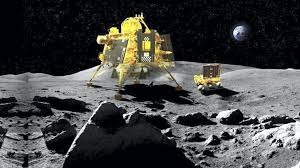
Follow WOWNEWS 24x7 on:
Updated: May 01, 2025 06:55

In a historic find, Indian researchers have announced that the Chandrayaan-3 mission has quantified volatile elements in the Moon's South Polar region, which is revealing traces of some of the oldest and most primitive lunar materials ever analyzed. With the Alpha Particle X-ray Spectrometer (APXS) on the Pragyan rover, scientists from the Physical Research Laboratory (PRL), Ahmedabad, have characterized soil samples at Shiv Shakti station-a region suspected to contain material that was spit out more than 4.3 billion years ago when SPA basin was being formed.
Key Highlights
The APXS tool recorded the concentration levels of important volatile elements-sodium (Na), potassium (K), and sulfur (S)-in lunar regolith at 23 points around the Chandrayaan-3 landing area.
Results indicated a remarkable sulfur enrichment and sodium and potassium depletion from earlier missions, including Apollo, Luna, and Chang'e, which predominantly landed in potassium- and rare earth element-abundant areas.
The distinctive chemical signature at Shiv Shakti station indicates the existence of ancient lunar mantle material, probably excavated by the SPA basin's gigantic impact and subsequently incorporated into the local soil by later meteorite impacts.
The results confirm the lunar magma ocean hypothesis, which suggests that the early crust of the Moon developed as lighter minerals floated on a global magma ocean, with deeper material-including sulfur-rich rocks of the mantle-still below.
The Chandrayaan-3 location's closeness to the rim of the SPA basin, away from the potassium-rich Procellarum KREEP Terrane, offers the unusual prospect of investigating the deep interior and ancient past of the Moon.
This finding makes the Chandrayaan-3 landing site an ideal spot for obtaining primitive mantle samples, an asset not being offered by earlier lunar missions or samples.
The 700-gram APXS instrument carried out 23 individual measurements across ten days to report an unusually consistent composition within the visited area. In addition to making new evidence-based speculations more conclusive about the initial development of the Moon, this also brings into play novel modes of inquiry on the process-formations leading to the development of the Moon as well as that of the initial solar system.
Source names: ISRO, Physical Research Laboratory (PRL), Nature Communications Earth and Environment, Times of India


